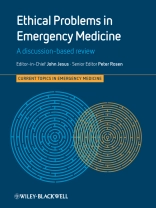This book is designed to consolidate the relevant literature as well as the thoughts of professionals currently working in the field into a practical and accessible reference for the emergency medical technician, student, nurse, resident, and attending emergency physician. Each chapter is divided into four sections: case presentation, discussion, review of the current literature, and recommendations. Designed to serve simultaneously as a learning and reference tool, each chapter begins with a real case that was encountered in an ED setting. The case presentation is followed by a short discussion of the case, as if at a morbidity and mortality conference, by a panel of experienced attending physicians explaining how they would approach the ethical dilemmas associated with the case, and a review of the existing literature.
Зміст
Contributors, ix
Preface, xiii
Section One: Challenging professionalism
1 Physician care of family, friends, or colleagues, 3
Taku Taira, Joel Martin Geiderman
2 The impaired physician, 15
Peter Moffett, Christopher Kang
3 Disclosure of medical error and truth telling, 27
Abhi Mehrotra, Cherri Hobgood
4 Conflicts between patient requests and physician obligations, 37
Shellie L. Asher
5 Judgmental attitudes and opinions in the emergency department, 47
V. Ramana Feeser
6 Using physicians as agents of the state, 57
Jeremy R. Simon
Section Two: End-of-life decisions
7 Family-witnessed resuscitation in the emergency department:making sense of ethical and practical considerations in anemotional debate, 69
Kirsten G. Engel, Arthur R. Derse
8 Palliative care in the emergency department, 79
Tammie E. Quest, Paul De Sandre
9 Refusal of life-saving therapy, 89
Catherine A. Marco, Arthur R. Derse
10 Revisiting comfort-directed therapies: death and dying in theemergency department, including withholding and withdrawal oflife-sustaining treatment, 99
Raquel M. Schears, Terri A. Schmidt
11 Futility in emergency medicine, 117
Arthur R. Derse
Section Three: Representing vulnerable populations
12 The care of minors in the emergency department, 129
Chloë-Maryse Baxter
13 Chemical restraints, physical restraints, and otherdemonstrations of force, 139
Michael P. Wilson, Christian M. Sloane
14 Capacity determination in the patient with altered mentalstatus, 149
Michael C. Tricoci, Catherine A. Marco
15 Obstetric emergency: perimortem cesarean section, 15
Kenneth D. Marshall, Carrie Tibbles
Section Four: Outside influence and observation
16 Non-medical observers in the emergency department, 169
Joel Martin Geiderman
17 Religious perspectives on do-not-resuscitate (DNR) documentsand the dying patient, 179
Avraham Steinberg
18 Non-physician influence on the scope and responsibilities ofemergency physicians, 187
Laura G. Burke, Jennifer V. Pope
19 Privacy and confidentiality: particular challenges in theemergency department, 197
Jessica H. Stevens, Michael N. Cocchi
Section Five: Emergency medicine outside the emergencydepartment
20 Short-term international medical initiatives, 209
Matthew B. Allen, Christine Dyott, John Jesus
21 Disaster triage, 221
Matthew B. Allen, John Jesus
22 The emergency physician as a bystander outside the hospital, 237
Zev Wiener, Shamai A. Grossman
23 Military objectives versus patient interests, 247
Kenneth D. Marshall, Kathryn L. Hall-Boyer
Section Six: Public health as emergency medicine
24 Treatment of potential organ donors, 261
Glen E. Michael, John Jesus
25 Mandatory and permissive reporting laws: conflicts in patientconfidentiality, autonomy, and the duty to report, 271
Joel Martin Geiderman
26 Ethics of care during a pandemic, 287
John C. Moskop
Section Seven: Education and research
27 Practicing medical procedures on the newly or nearly dead, 301
Ajay V. Jetley, Catherine A. Marco
28 Ethics of research without informed consent, 311
Dave W. Lu, Jonathan Burstein, John Jesus
Appendix: useful resources, 321
Alexander Bracey
Index, 325
Про автора
John Jesus, MD, Chief Resident, Department of Emergency Medicine, Beth Israel Deaconess Medical Center, Boston, MA, USA; Clinical Instructor, Department of Emergency Medicine, Christiana Care Health System, Newark, DE, USA.
Peter Rosen, MD, FACS, FACEP, Director of Education, Beth Israel Deaconess Medical Center; Senior Lecturer in Medicine, Harvard Medical School, Boston, MA, USA.
Shamai A. Grossman, MD, MS, FACEP, Vice Chair for Resource Utilization; Director, Cardiac Emergency Center, Division of Emergency Medicine, Beth Israel Deaconess Medical Center; Assistant Professor of Medicine, Harvard Medical School, Boston, MA, USA.
Arthur R. Derse, MD, JD, FACEP, Director, Center for Bioethics and Medical Humanities, Julia and David Uihlein Professor of Medical Humanities; Professor of Bioethics and Emergency Medicine, Institute for Health and Society, Medical College of Wisconsin, Milwaukee, WI, USA.
James G. Adams, MD, Professor and Chair, Department of Emergency Medicine, Feinberg School of Medicine, Northwestern University, Northwestern Memorial Hospital, Chicago, IL, USA.
Richard Wolfe, MD, Chief of Emergency Medicine, Beth Israel Deaconess Medical Center; Associate Professor of Medicine, Harvard Medical School, Boston, MA, USA.












